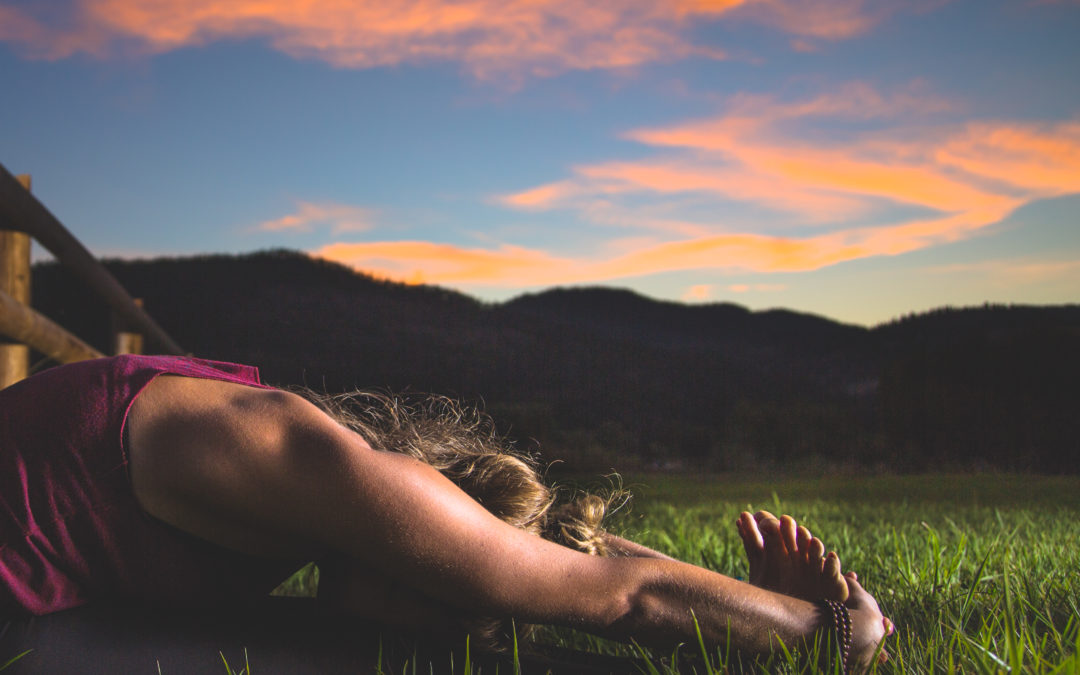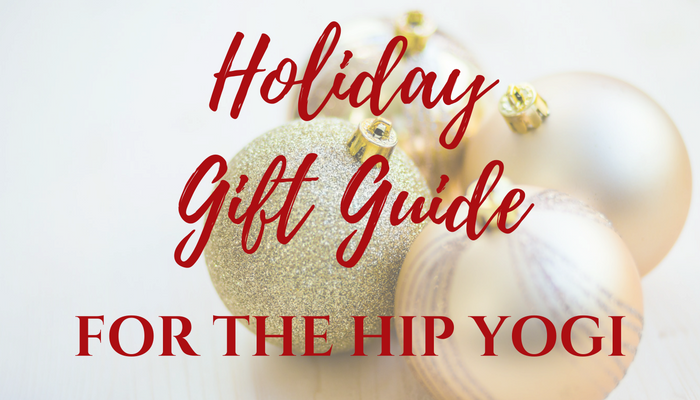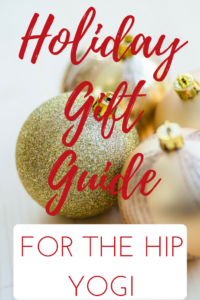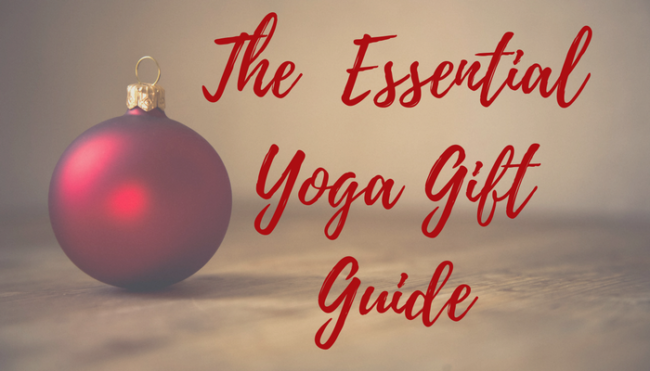
by Caroline | Dec 4, 2016 | Yoga
Here is holiday gift guide with all the goodies that the yogi in your life will ever need! Whether you are a beginner or well into your practice, there are somethings that are just essential! This yoga gift guide contains what I think are the most essential tools to have in your yoga practice.
Anyway, if you’re anything like me, you do a lot of your holiday shopping online. I’ve actually made a point to not go into any stores this holiday season, with the exception of a few local business in my town I like to support. I’m doing my best to get everything online.
Funny story, I accidentally signed up for a years worth of Amazon prime- long story. I felt really stupid at the time, but it turned out to be the best thing ever because now when I need something I just order it and it’s at my house in 2 days. No more trips to the big box stores, and such a time saver. AMAZON FOR THE WIN. In the spirit of transparency, the links I have provided are affiliate links, which means I make a small commission on stuff you buy through my links. However, I wouldn’t recommend anything I didn’t either use myself or completely love!
Holiday self care for me includes not driving myself crazy with crowded malls, parking spot wars, and over spending. Hence my love for online shopping. I hope this yoga gift guide helps you simplify your holiday shopping!


Sivan 6-Piece Yoga Set
This is great because if you’re a total beginner and have no yoga gear whatsoever this have everything for super cheap. The mat is extra thick which I love for my bony knees (ouch). It includes blocks, towels and a strap. If you never buy another yoga related item after this you’ll still have everything you need.


Peace Yoga Yoga Mat Tote Bag – Tree Design
This yoga mat bag is so adorable and I love the different designs it comes with (the elephant one is my favorite). Since I’m constantly running around, I always keep a mat in my car ready to go if I decide to go take a class on a whim. It’s essential, in my opinion to have a portable yoga mat ready to go at any moment. Keep your mat in this bag by the door or in your car and you’re always ready for whatever yoga adventure you take that day!


Gaiam Premium Print Yoga Mat
I personally have this mat, mainly because I love the designs, but I find it great for standing and balancing poses because it’s on the thinner side so balancing feels a lot sturdier. Since it’s thin too it rolls up quite small and is my “stay in the car” yoga mat for when I feel like hitting a class after work.


The Combo Yoga Mat 1 mm. TRAVEL VERSION.
If you’re serious about yoga then get yourself a travel mat, girl! The design on this one is great (obvi) but I also like that it is machine washable and foldable. When you travel a lot and take your mat all over the place it’s crucial that you are able to wash the heck out of it (because hotels…ew).


Aurorae Non Slip Hot Microfiber Yoga Mat Towel, 72″ x 24″, AQUA TIE DYE
I’ll be honest, I absolutely hate hot yoga. I tried it once and thought I was going to die. I’ve never been good dealing with temperature extremes. I have a very sensitive internal thermostat, so it’s just not for me. But for those of you who are, you definitely need a towel because it can get like viagra falls in those classes, ya know what I mean? Just do yourself a favor and get a towel if you are ever considering a hot yoga class.


SukhaMat Yoga Knee Pad – NEW! 15mm Thick – The best yoga knee pad for a pain free practice. Cushions pressure points. Complements your full-size yoga mat. Practice in Comfort! (Black)
So this is new to me and I’m pretty glad I found it! I have extremely bony knees and have such a hard time on regular mats when it comes to poses that put weight on the knees like a low lunge. I constantly have to put a blanket under my knee or fold up the mat. I don’t know why it tool me this long to realize that these things existed, but I’m so glad they do!


Mandala The Yoga Massage Ball
These little guys are so great for releasing tight muscles and can eliminate muscle knots and tension through gentle massage using your own body weight. They are ideal for deepening your yoga practice, self-soothing massage,and recovery from injury. I know a lit of people who swear by these things!


Yoga Wheel
Every time I see one of these things I’m like “Oh I want to try that!” Not only does it look like a lot of fun but it can really add to your yoga practice by helping you deepen more into poses and improve flexibility, balance and core strength. For one small tool it has a lot of uses, like more than you can imagine. I think it’s definitely worth checking out.


Stick-e Knee and Wrist Saver (Blue)
For those of you who experience pain in the wrists or knees during weight bearing poses this simple little tool is a life saver! It takes the right off the knee caps and reduces the weight and pressure on wrists when in poses like plank or downward dog. Now, I have to say as a yoga instructor often the cause of wrist pain in these poses is the result of misalignment and incorrect weight distribution in the hands. SO I usually instruct my students into correct alignment if they have pain. But if you still experience pain or have an injury this is a great next option.


Perfectly Imperfect: The Art and Soul of Yoga Practice
It’s hard for beginners to understand the deep changes that happen as a result of a regular yoga practice. Often people are discouraged because they don’t feel any different after one class. This book takes readers beyond the foundations of the practice and talks about everything that happens in their bodies and minds after they get into a yoga pose. That is where the true transformation occurs, and where deep spiritual and emotional growth happens.
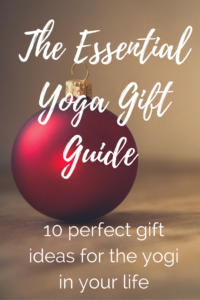
The Essential Yoga Gift Guide
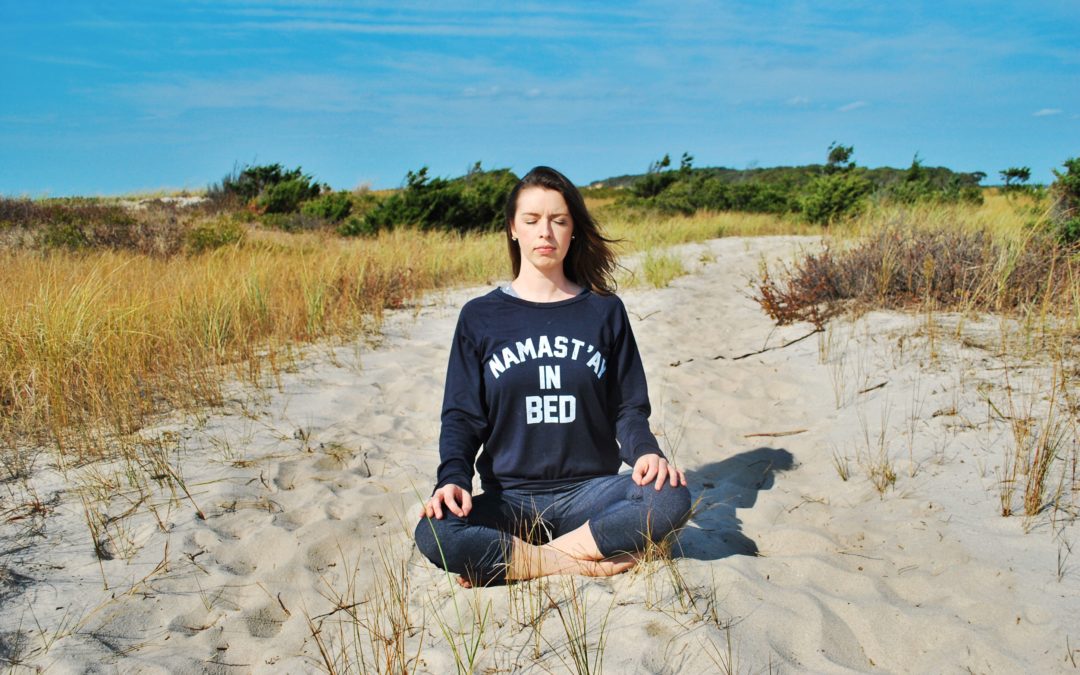
by Caroline | Nov 26, 2016 | Yoga
WHAT IS “OM”?
You’re sitting in yoga class and the teacher invites everyone to chant a round of “Om” together. Ever wonder what it means or why we do it? You’re not alone. For many it can seem uncomfortable or foreign. By knowing what it means and why you’re chanting it can make a big difference in your yogic experience.
Describing what “Om” is and why we do it is a bit difficult because it’s a vague concept that goes beyond definition. It’s something that requires experience to understand, otherwise it can feel a bit meaningless.
Let’s begin by dispelling some of the confusion and mysteries surrounding the practice of chanting “Om.”
Om is a Sanskrit term that translates as “source” or “supreme.” However it’s not the meaning that is most important to the chanting yogis.
The sound vibration of the word is most important. You experience “Om” more than just saying it.
Om is that mysterious aspect of all life that cannot be summed up by words. It is everything. All in existence. It’s the seed of all creation; like how a seed holds the power and energy of an entire plant within itself. This small sound contains the meaning of the universe. Some have said that recordings of the vibrations that Earth makes in space can sound a bit like “Om” but that’s really up for you to decide.
Even though Om sounds like one sound it really can be broken down into three (and even four) parts.
- “Ahhh”– represents the start of the universe, creation, and birth. The sound vibration itself is produced at the back of the throat. The vibration can be felt deep into the abdomen. This vibration brings you in connected awareness of your creation and your true essence.
- “Ooooh”– represents the energy of the universe, or life. It connects us to the sense that deep within us there is something more beyond what we can see or hear. Chanting this sound, the vibration moves from the back of the mouth to the middle, resonating on the palate.
- “Mmmm”-represents transformation or death. The transformative energy of the universe that brings you to a state of oneness with all creation. The vibration of this sound is made at the lips, vibrating the crown of the head
- Silence– Often considered the fourth sound in “Om” the silent but very real energy that resonates after the room finishes the chant. This represents the experience of pure consciousness.
WHY DO WE CHANT IT?
Chanting “Om” helps to bring the energy of the room together in harmony to open and close a practice by changing and breathing in unison.
Typically yoga classes begin with three rounds of chanting “Om” and one more at the end of the class. By tuning the attention in during this mantra, you can connect your mind and body on a deeper level. We are reminded of the eternal joy and peace that resides in all of us during this moment. It is from that place that we begin our practice.
By chanting “Om” at the end of the class in unison, it confirms total respect for the practice and each other. It seals the energy that was cultivated during the practice so you can call on it during your everyday life when times get stressful. I find that after a good yoga class my “Om” at the end resonates deeper into all corners of my mind, body, and spirit.
HOW TO GET THE MOST OUT OF CHANTING “OM”
KNOW: Understand the meaning and purpose of chanting “Om” during your practice (which you already do since you’ve just read this, so YAY you!)
FEEL: Slowly produce each individual sound “aaahhh, oooooh, mmmmm” spending time at each one, feeling the actual vibration in your body. Notice how the place of resonance changes from sound to sound.
VISUALIZE: Notice how the sound vibration moves upward from the abdomen to throat, then ending at the crown of the head. Visualize that vibration as energy moving upward through the chakras. This will help to engage in the subtle body energy field to heighten your connection to the universe.
TUNE IN: With each repetition of “Om” tune in deeper by bring your attention to the silence after each chant. Noticing the difference in how your body feels between the sound production and the silence. You can almost feel lingering vibrations in your body even after you’ve finished the last sound.
Taking these into consideration the next time you take a yoga class should enhance the state of peace and wellbeing, relaxing your nervous system and preparing you for your yoga practice.
Now I want to hear from you!! In the comments below share what chanting “Om” means to you.
xo,

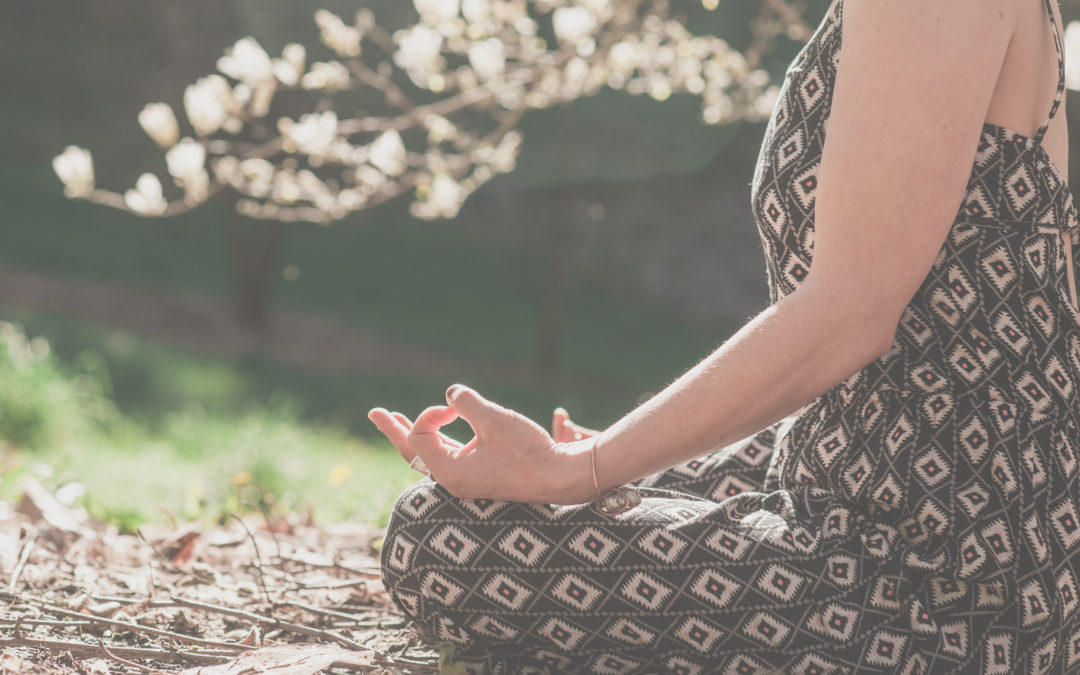
by Caroline | Jul 8, 2016 | Yoga
Why does my yoga teacher always remind me to breathe?
Yoga and the breath are intricately connected. Understanding the yogic breath will help you deepen your practice and increase the connection between mind and body. The foundation of any yoga practice is the breath. The term Pranayama comes from the Sanskrit “prana” meaning life force energy, and “ayama” meaning freeing or extending. Therefore pranayama is the conscious control of the prana through our manipulations of the breath. You may hear this term during a yoga class, and all it means is that you are going to do some type of conscious breathing exercise.
Here is a brief introduction to some terms and breath exercises you may encounter on your journey to zen.
The Natural Breath
An important place to start is noticing the natural breath. Although it’s not technically a pranayama practice because it’s not controlling the breath, the natural breath is the basis for your pranayama practice. The natural breath is unmanipulated. For example when in Savasana at the end of a yoga practice the breath is naturally flowing, as we surrender and release into the pose.
However, many of us have abandoned our natural breath, as stress, tension, and pain all affect how we breathe. Over time we habituate an unhealthy breathing pattern, originating from the upper chest, rather than the abdomen. When our breath resides in the upper chest it’s shallow, making it difficult for enough oxygen to enter.
During meditation or savasana, notice where your breath is coming from without trying to change it. Notice what parts are moving on the inhale and the exhale. If your upper chest, collar bones, and shoulders are moving and your abdomen is relatively still then that is an unnatural breath. This is often known as chest breathing. In chest breathing the diaphragm does not extend downward completely and the inhalation is in the chest area only. The breath is shallow, and can contribute to anxiety and physical ailments.
If your abdomen and lower ribs expand and contract upon inhalation and exhalation, and the upper chest and shoulders remain still, then it is a more natural breath. This is also referred to as diaphragmatic breathing. In diaphragmatic breathing, the abdominal cavity and thoracic cavity are engaged to draw in a deeper breath. The diaphragm moves down, causing air to fill the lungs, bottom to top, side to side, and front to back.
The Full Yogic Breath
When practicing the full yogic breath we breathe into three sectors of the torso one at a time, then release the breath one sector at a time.
First inhale into the belly, extending outward. Pause. Then inhale into the mid chest as the ribs expand to the front, back and sides. Pause. Then inhale into the upper chest, the area just under your collar bones. Progressively filling up from bottom to top, creating expansion in all directions. Then gradually release the breath without forcing it out.
Ujjayi Breath (pronounced oo-jye)
In sanskrit ujjai means triumphantly uprising or expanding. In this breath the “prana” or life force energy is flowing upward through all of the chakras. It is said that when prana is flowing through the chakras we are in a state of union or oneness.
The ujjayi breath is done through the nostrils with the lips closed. The breath is even and steady. There is a slight contraction at the back of the throat which will make a subtle hissing sound. Basically it’s like you’re trying to fog up a mirror but with the mouth closed. The inhalation and exhalation should me slightly audible. This breath is often done during a yoga practice, pairing inhalation and exhalation with the movements in and out of poses. It builds heat in the body and connects you to the flow of the breath. According to BKS Iyengar this is also good for those suffering from low blood pressure, asthma, and depression, as it invigorates the nervous system.
If you’re just getting into yogic breath work I’d recommend checking out Donna Farhi’s The Breathing Book which is is a great introduction and gives an overview of why it’s so important in your yoga practice. For those more experienced yogis Gregor Maehle’s Pranayama: The Breath of Yoga is perfect for integrating essential pranayama exercises into your yoga practice.
Now that you know about the importance of the breath, if you are looking to deepen your meditation practice click here for some information to help you get the most out of your time in meditation.
xo,

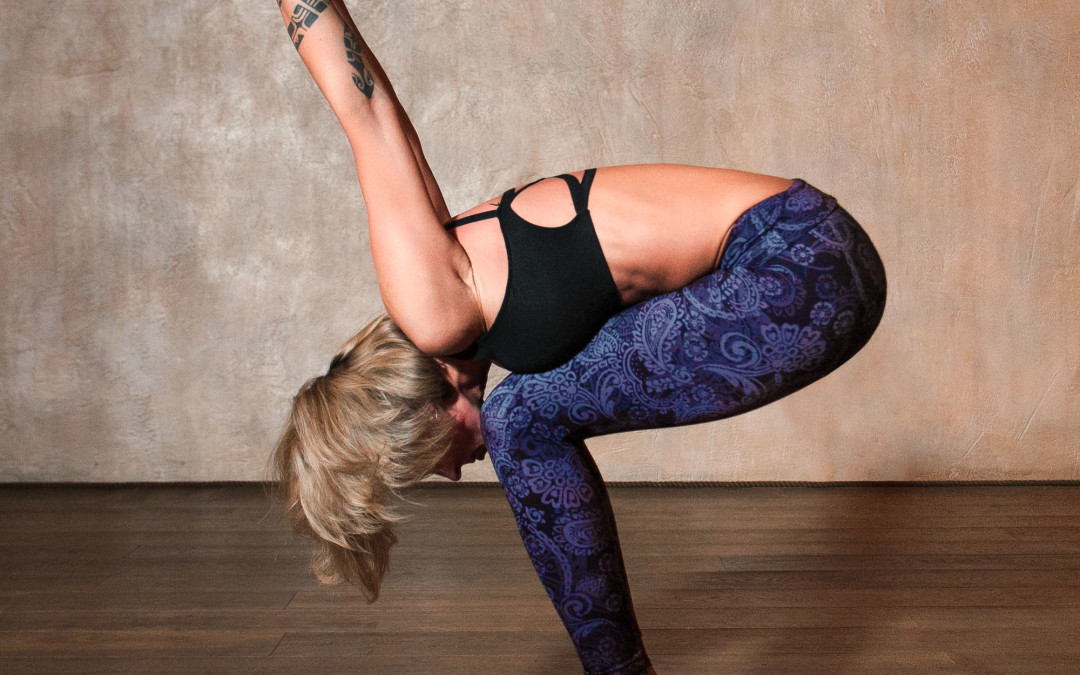
by Caroline | Mar 5, 2016 | Yoga
With so many different flavors of yoga out there it can be overwhelming to someone who doesn’t feel “in” with all of the yoga lingo and culture. From the outside yoga can appear exclusive; only for the super bendy and former gymnast/cheerleader types.
Or maybe it doesn’t seem hard core enough for the body-builders, spinners or cross fitters. Or maybe it just never occurred to some people as something that they would benefit from. And then there are those who think it’s too late for them to start.
But here’s the good news! Yoga is so versatile that there is a style for everybody, at any age, or ability level. And it can benefit everyone who begins a practice.
I’ve become more passionate about getting the word out about yoga’s accessibility and benefits since working toward my yoga teacher certification. So a good place to start is to lay out the different choices to see what feels right for you.
Kundalini Yoga- the name is just fun to say (I think), but in sanskrit kundalini is the energy that resides at the bottom of your spine, and when ignited rises up through the seven chakras to the crown of your head, creating spiritual transformation and enlightenment. Kindalini yoga is the blend of spiritual and movement practices for igniting that energy, such as breathing, chanting, meditation, and asana (poses). The goal is to increase your spiritual experience, consciousness and awareness, increase will power and intuition, quiet the mind and release stress.
Hatha- Hatha yoga is what most people think when they hear the word yoga. It’s the most generic form of yoga out there, and combines physical poses and stretching with breath and movement. It’s not the most physically demanding, but it will help increase flexibility and calm the mind. Hatha yoga is on the gentler side, with less focus on alignment, or rigorous movement. Hatha is a good place for beginners to start without feeling overwhelmed.
Ashtanga- Like hatha yoga it combines breath and movement into sequences of poses that are done briskly to build heat in the body, toning muscles and strengthen the core. The main difference is that ashtanga always uses the same sequences of poses in every class, and is more physically demanding. So you can take a class at a new studio and still know exactly what’s coming. Physical and athletic types will enjoy this one.
Vinyasa– Similar to hatha and ashtanga, Vinyasa combines poses in sequences that flow one into another to keep the body moving. These classes are lively and playful. Unlike ashtanga no two classes are the same, as each teacher creates his or her own sequences of postures. This is good for weightloss, toning muscles, increasing flexibility and balance.
Bikram– Like in Ashtanga, Bikram follows the same, specific set of poses for each class, but it’s done in an hot environment, to encourage flexibility and detoxification through sweating. *Note* you will sweat buckets.
Iyengar– Iyengar yoga focuses on strict alignment principles in each pose. A pose may be held for a longer amount of time than in other yoga classes because it teaches you where every muscle, ligament and bone should be and what it’s doing. Although it may not go through quick sequences that build up a sweat, you will be surprised how difficult it can be to hold some poses while engaging in the correct muscles in the proper alignment. This is a great option for people with injuries or chronic because your instructor will help you get into each posture safely. When yoga poses are done in proper alignment there is very little chance of injury. When you’re going from one pose to another without any awareness of your body in space is where you may run into trouble.
Restorative– In restorative yoga you will only do about 5 or six poses in the whole class, but each pose is designed to take you into a deep state of relaxation and is supported with props such as blocks, blankets, bolsters, straps and sandbags. It helps our minds let go of the thought-chatter, so we can connect with the truest aspect of ourselves without the layers of our “story” clouding our mind. Restorative is healing and transformative by providing a physically supportive environment so the parasympathetic nervous system can get all cozy, relieving the effects of stress, trauma, and anxiety. Restorative yoga is pretty much good for anything that ails you, be it mental or physical.
Now I want to hear from you!
Share with me in the comments below: What form of yoga are you most drawn to?
XO,

